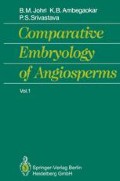Abstract
The history of “embryology” dates back to the age-old tradition of Arabs and Assyrians of dusting the male inflorescence of the date palm on to the female palm to obtain a good supply of dates. This religious ceremony indicated some sort of sex-blending. But, until the experiments of Camerarius (1694), no attention was paid to sexuality in plants. The only efforts till then were of Grew (1682) who treated the stamens as the male organs (of flowers) which induced the ovary to produce the fruit.
Access this chapter
Tax calculation will be finalised at checkout
Purchases are for personal use only
Author information
Authors and Affiliations
Rights and permissions
Copyright information
© 1992 Springer-Verlag Berlin Heidelberg
About this chapter
Cite this chapter
Johri, B.M., Ambegaokar, K.B., Srivastava, P.S. (1992). The Background. In: Comparative Embryology of Angiosperms. Springer, Berlin, Heidelberg. https://doi.org/10.1007/978-3-642-76395-3_1
Download citation
DOI: https://doi.org/10.1007/978-3-642-76395-3_1
Publisher Name: Springer, Berlin, Heidelberg
Print ISBN: 978-3-642-76397-7
Online ISBN: 978-3-642-76395-3
eBook Packages: Springer Book Archive

